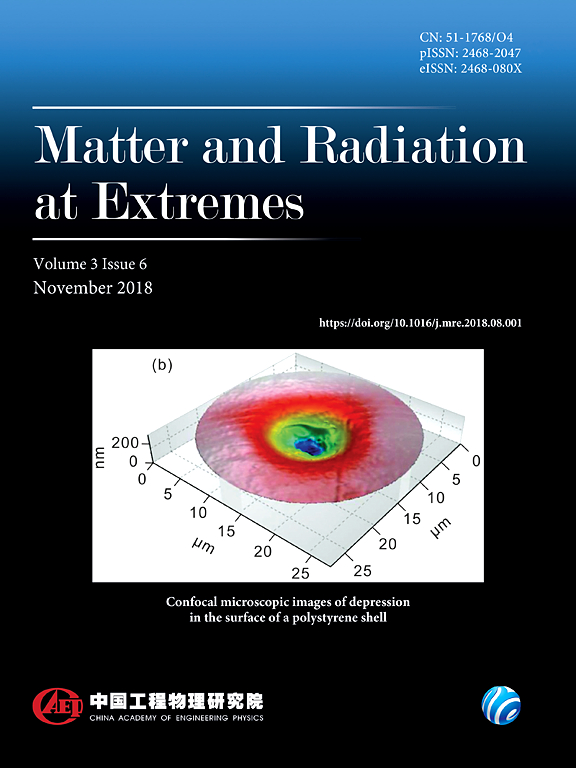用于大容积压力机超高温压实验的虚拟温度计
IF 4.7
1区 物理与天体物理
Q1 PHYSICS, MULTIDISCIPLINARY
引用次数: 0
摘要
超高温-高压实验对于了解物质的物理和化学特性至关重要。最近开发的掺硼金刚石(BDD)加热器使得在大容量压力机中进行此类熔化实验成为可能。然而,由于缺乏合适的温度计,对 2600 K 以上的温度以及 BDD 加热器内部温度分布的估计并不准确。在此,我们建立了一个三维有限元模型,作为虚拟温度计来估算 2600 K 以上的温度和温度场。与以往研究中提出的虚拟温度计相比,该虚拟温度计的优势在于它同时考虑了交流和直流加热模式,压缩后电池组件的实际尺寸,电极、热电偶和砧的影响,以及压力传输介质的散热。虚拟温度计再现了在 2.8-7.9 MN(19 至 28 GPa)压力负荷下 2600 K 以下超高温压实验的功率-温度关系,其误差在实验不确定性范围内。此外,我们的模型显示,BDD 加热器内部的温度分布(沿径向为 19-26 K/mm,沿纵向为 <83 K/mm)比石墨或 LaCrO3 加热器等传统加热器内部的温度分布(100-200 K/mm)更均匀。因此,我们的研究为地球和材料科学领域使用 BDD 加热器进行超高温实验提供了可靠的虚拟温度计。本文章由计算机程序翻译,如有差异,请以英文原文为准。
A virtual thermometer for ultrahigh-temperature–pressure experiments in a large-volume press
Ultrahigh-temperature–pressure experiments are crucial for understanding the physical and chemical properties of matter. The recent development of boron-doped diamond (BDD) heaters has made such melting experiments possible in large-volume presses. However, estimates of temperatures above 2600 K and of the temperature distributions inside BDD heaters are not well constrained, owing to the lack of a suitable thermometer. Here, we establish a three-dimensional finite element model as a virtual thermometer to estimate the temperature and temperature field above 2600 K. The advantage of this virtual thermometer over those proposed in previous studies is that it considers both alternating and direct current heating modes, the actual sizes of cell assemblies after compression, the effects of the electrode, thermocouple and anvil, and the heat dissipation by the pressure-transmitting medium. The virtual thermometer reproduces the power–temperature relationships of ultrahigh-temperature–pressure experiments below 2600 K at press loads of 2.8–7.9 MN (∼19 to 28 GPa) within experimental uncertainties. The temperatures above 2600 K predicted by our virtual thermometer are within the uncertainty of those extrapolated from power–temperature relationships below 2600 K. Furthermore, our model shows that the temperature distribution inside a BDD heater (19–26 K/mm along the radial direction and <83 K/mm along the longitudinal direction) is more homogeneous than those inside conventional heaters such as graphite or LaCrO3 heaters (100–200 K/mm). Our study thus provides a reliable virtual thermometer for ultrahigh-temperature experiments using BDD heaters in Earth and material sciences.
求助全文
通过发布文献求助,成功后即可免费获取论文全文。
去求助
来源期刊

Matter and Radiation at Extremes
Physics and Astronomy-Atomic and Molecular Physics, and Optics
CiteScore
8.60
自引率
9.80%
发文量
160
审稿时长
15 weeks
期刊介绍:
Matter and Radiation at Extremes (MRE), is committed to the publication of original and impactful research and review papers that address extreme states of matter and radiation, and the associated science and technology that are employed to produce and diagnose these conditions in the laboratory. Drivers, targets and diagnostics are included along with related numerical simulation and computational methods. It aims to provide a peer-reviewed platform for the international physics community and promote worldwide dissemination of the latest and impactful research in related fields.
 求助内容:
求助内容: 应助结果提醒方式:
应助结果提醒方式:


